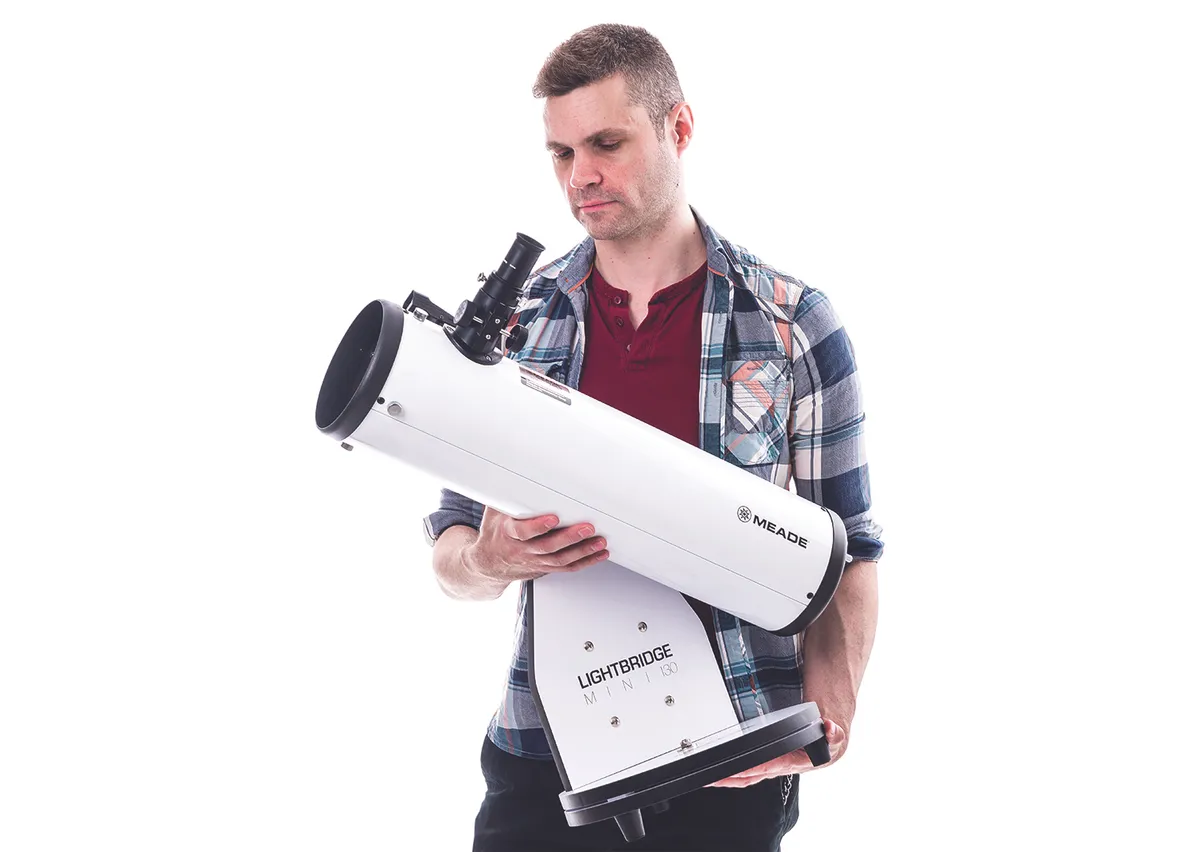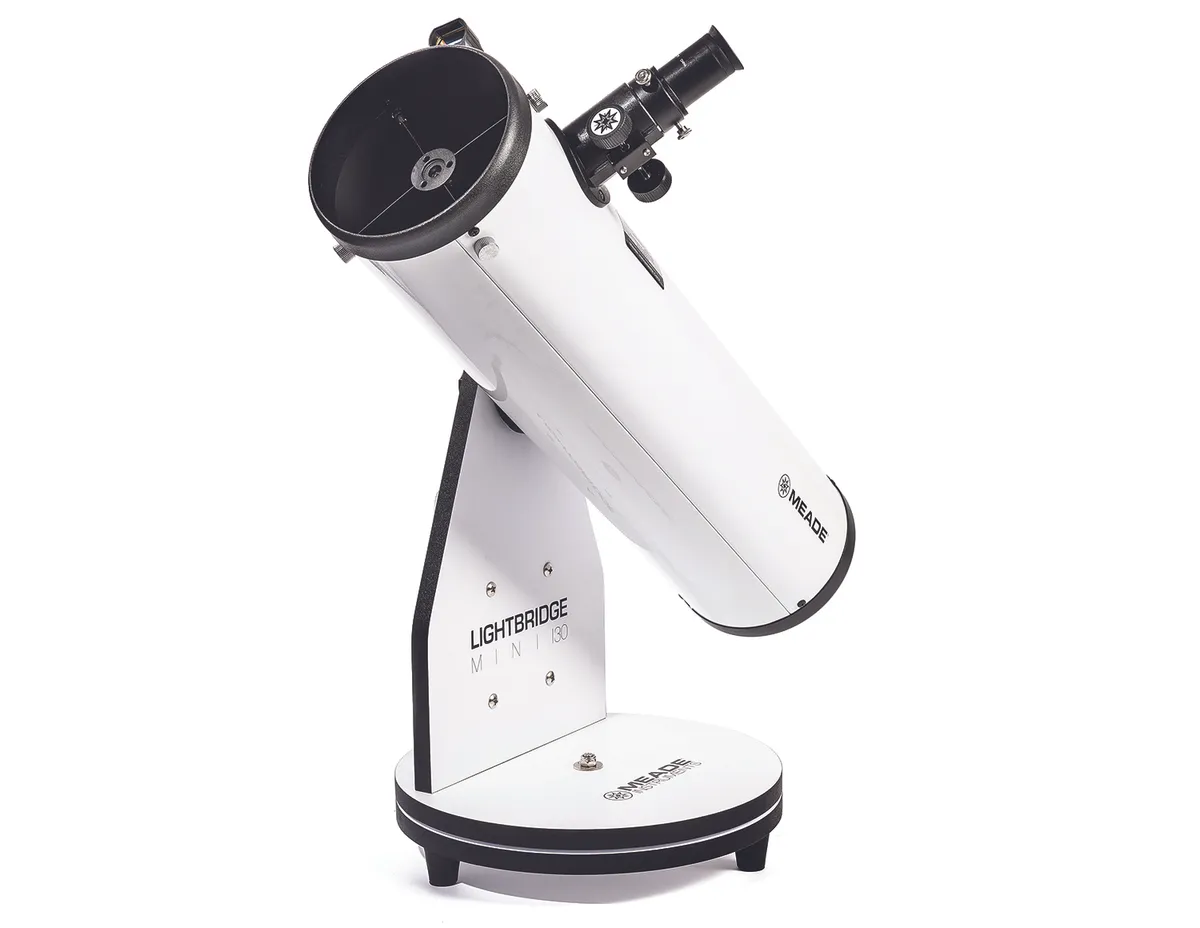The miniature Dobsonian is a recent trend; now Meade has entered this fledging market with its LightBridge Mini 130, a lightweight, tabletop instrument with a 5-inch aperture.
This Dobsonian is shipped already assembled and is well packaged for protection during transit, with a smaller box containing a red-dot finder, two eyepieces (26mm and 9mm), instructions and Meade’s Autostar planetarium software.
The eyepieces are 1.25-inch fit and give magnifications of 25x and 72x; in other words, low- and medium-powered views.
The finder is a zero-magnification variety and the brightness of its red dot is adjustable, though we found that the lowest setting was best so as not to overpower the view.
The single-arm mount delivers free movement along both the azimuth and altitude axes and is easy to operate.
The telescope tube attaches via a Vixen-style clamp and can be removed if needed. This allows you to opt for an alternative mount (such as an EQ1 or EQ3) if you wish to upgrade to an equatorial system at a later date.
But, because the telescope is fixed via a Vixen-style bar in this way, we did find that in some positions it was not easy to reach around and look through the red-dot finder to align on a target without stretching over the focuser assembly and eyepiece.
Perhaps if the finder was located a little closer to the focuser this might improve the system.
This telescope features in our lists of the best telescopes for beginners and best budget telescopes. For more models like this, read our guide to the best tabletop telescopes.

We placed the LightBridge Mini 130 on the observing trolley we often use for a laptop and were quickly in action with the 26mm eyepiece.
We checked the field of view by aiming at the bright star Regulus in Leo, and were pleased to see it was pin sharp across 75 per cent of the view with slight distortion towards the edge.
The 25x magnification of the 26mm eyepiece delivers a wide field of view of just over 2.5º, so even quite large star clusters such as M44, the Beehive Cluster in Cancer, will fit in the view.
The galaxy pair of M81 and M82 in Ursa Major could be seen together even when we changed to the 9mm eyepiece (72x magnification) and were a lovely sight with a hint of subtle structure running along the almost edge-on disc of M82.
Messier hopping
M51, the Whirlpool Galaxy in Canes Venatici, was small but relatively bright in the 26mm eyepiece, its companion galaxy M51a clearly visible, while the 9mm eyepiece enhanced the view – revealing a hazy disc surrounding the main core of M51.
Turning to what few nebulae there were to see in the spring sky, we enjoyed a good view of M57, the Ring Nebula in Lyra, with a nice dark hollow at its centre, and nearby M27, the Dumbbell Nebula, showed hints of structure through the 9mm eyepiece.
The view was still reasonably detailed even after adding 2x Barlow lens of our own, but as this also had the effect of enhancing the motion of the sky we had to keep centring the view regularly.
Multiple stars and the planets require higher magnification as a rule, so we tried this using the 9mm eyepiece – we were able to pick out and split Castor in Gemini and Algieba in Leo.
Jupiter also required the 9mm eyepiece and through it we could easily see the two main belts and the four Galilean moons.In moments of steady seeing we could even make out hints of more structure.
Our near neighbour, the Moon, appeared bright but revealed plenty of craters that you can explore and impress your neighbours with.
Overall this is a simple to use tabletop Dobsonian that has the potential to fire the imagination of young and old, and give good views of a wide range of targets.

Pick up and go anywhere
Tabletop telescopes are naturally portable and easy to set up anywhere there is a flat surface to stand them on that leaves the eyepiece accessible.
Because of this you can be viewing through the LightBridge Mini 130 in minutes – free of the hassle of unfurling a tripod, polar aligning or setting up a Go-To.
You could easily take it to a dark site away from home, or simply rush it out into your garden to catch elusive gaps in the cloud that might be too brief for more advanced setups.
Appealing to a wide range of people, from the young to not so young, it is also a great way to introduce the Universe to anyone even vaguely interested in astronomy and space.
Small instruments are often considered inferior to more complicated ones, but in our experience the value of a telescope entirely depends on the user.
Certainly, the LightBridge Mini 130 provides views that can inspire a greater appreciation of the night sky.
Eyepieces
Two basic eyepieces are supplied, a 26mm giving 25x magnification and a 9mm giving 72x magnification. They worked well for this basic system and gave pleasing views of a wide range of celestial targets. We did feel that both could be enhanced with the addition of a 2x Barlow lens.
Focuser
The focuser is a basic rack and pinion style and takes 1.25-inch fit eyepieces. There was a little play when racking in and out, but generally it did the job intended. The end is threaded to accept T-ring adaptors, although most DSLRs would be too heavy for this setup.
Mount
The wooden, single-arm altaz mount gave free movement in azimuth. The altitude axis movement is smooth in use and tension is adjustable using a nice chunky knob at the side. The telescope is attached to the mount with a Vixen-style barand can be removed for storage.
Finder
A red-dot finder is a reasonable choice for a telescope of this size as it is simple to use and quite lightweight. The brightness of the red dot can be adjusted, though for most uses we found the dimmest setting the best so it didn’t overpower the view.
Optics
The 5-inch parabolic mirror has a relatively short (fast) focal length of 650mm, giving the system a focal ratio of f/5. The optics performed reasonably well for their size and provided a range of pleasing views from the Moon and planets to brighter deep-sky targets.

Vital stats
- Price £225
- Aperture 130mm (5.1 inches)
- Optics Parabolic mirror
- Focal length 650mm (f/5)
- Mount Wooden altaz
- Extras Red-dot finder, 9mm and 26mm eyepieces (1.25-inch fit), Autostar software
- Weight 6.1kg
- Supplier Hama
- https://uk.hama.com
- Tel 0333 123 4262
Paul Money is BBC Sky at Night Magazine's reviews editor. This review originally appeared in the July 2016 issue of BBC Sky at Night Magazine.
